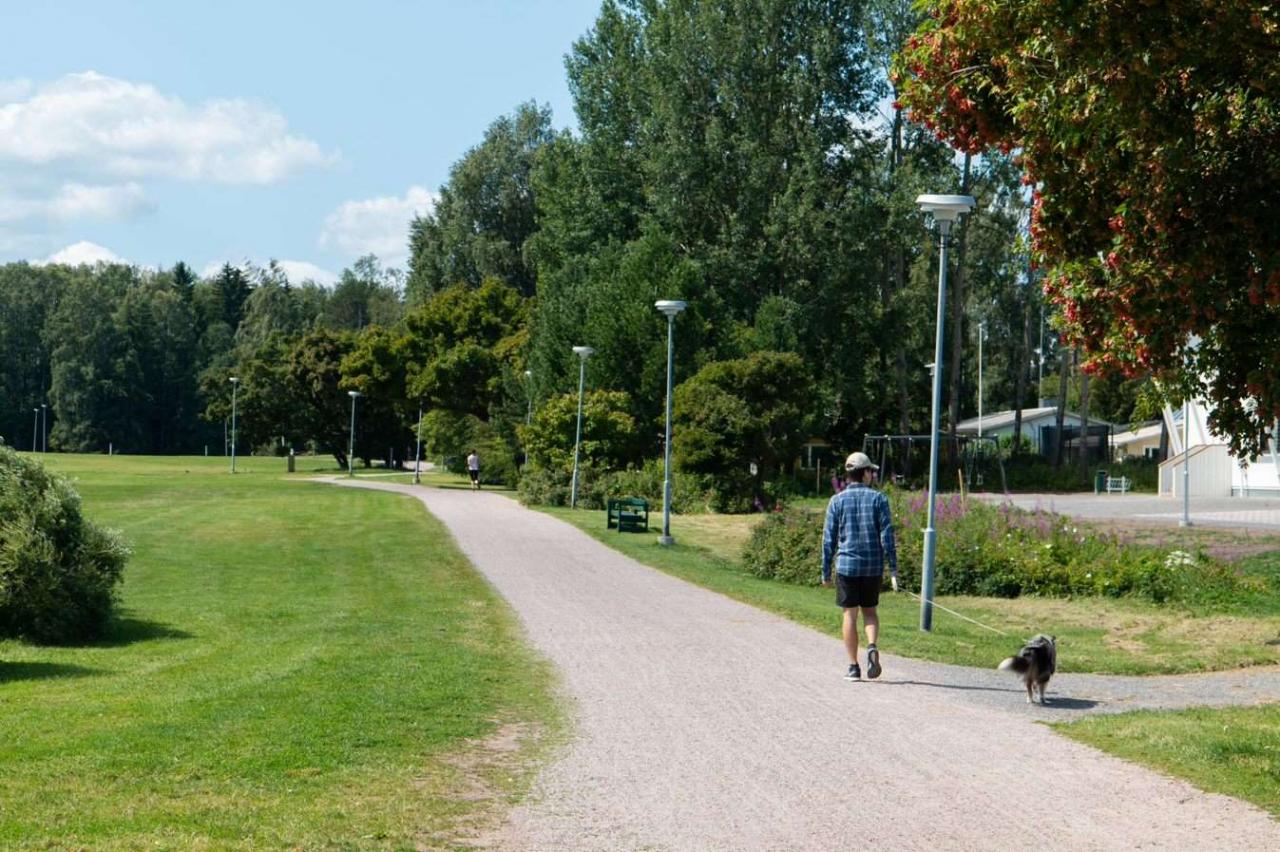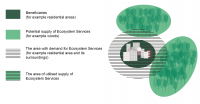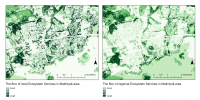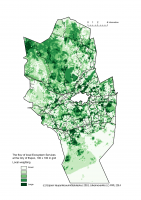
Espoo is one of the very first cities to use ecosystem service study as a perspective for planning the blue and green infrastructure and future land use of the city. To achieve this, Espoo created an Ecosystem Service Analysis, in which the spatial variations in the number of different regulating, maintenance and cultural ecosystem services are mapped at the selected area.
Espoo (FIN) is a rapidly growing city known for its closeness to nature in the Helsinki metropolitan area. In the future, the estimated fast population growth of the city is likely to cause pressure on green infrastructure as well as demand and maintenance of ecosystem services. In 2018, the Urban Planning Department at the City of Espoo was one of the very first actors to conduct a comprehensive analysis of the ecosystem services in the city. The method was created for the city by the project team, which now shares the secrets of the Ecosystem Service Analysis for other cities and institutions to utilise as well.
In the study, ecosystem services were defined as a supply of certain direct or indirect services the ecosystem provides to humans (Fisher et al. 2009). The beneficiary from the certain service can be a person or a community. When carefully planned and implemented, the blue-green infrastructure of a city can maintain all the essential ecosystem services, support the health of the people and mitigate impacts of environmental hazards.
How was the Ecosystem Service Analysis made?
The study aimed to maintain the quality and pleasantness of the environment together with ecological values and biodiversity. The analysis was made in order to define, which areas have an important role to supply diverse nature benefits for the people. Also, the specific ecosystem services, their attributes and weighting were analysed for the purposes of the study.
In addition to the actual service supply, the study highlighted the importance of demand for the ecosystem services and the location of the beneficiaries (figure 1) (Wolff et al. 2014, see also Syrbe et al. 2017). This means two green areas may have the same potential to supply ecosystem services, but the location and number of people nearby vary, which means greenspaces at proximity to residential areas have a higher demand for ecosystem services and are therefore given a higher weighting.

Figure 1. Ecosystem Service Analysis took into account the potential ecosystem service supply and the demand for these services by humans. Therefore, the most important areas regarding ecosystem services are located close to the residential areas.
The ecosystem services were mapped at 10 x 10 m grid for 25 individual classes of regulating, maintenance, provisioning and cultural ecosystem services. Variables in the study included, for instance, recreational hotspots, stormwater management, pollination and seed dispersal and nature-related cultural heritage. In the study, assessment of ecosystem services was conducted by connecting primary data, modelled flow or expert knowledge of likely causal variables with high-resolution land cover classification.
In Espoo, the analysis was made in two stages with both local and regional weighting (figure 2). This was made, because some ecosystem services can be produced more away from the beneficiaries, outside the urban structure or even globally. Such regional ecosystem services are, for example, regionally important recreational areas and global climate regulation. Local ecosystem services, on the other hand, can´t be utilized outside the urban structure, since they have a direct impact only to their immediate surroundings.

Figure 2. Locally (left) and regionally (right) important ecosystem services at Matinkylä neighbourhood, Espoo. Small greenspaces in the urban structure are important locally. On a regional level, larger greenspaces provide more ecosystem services. In Espoo, also the Baltic Sea and its waterfront provides a high diversity of different supplies.
What kind of ecosystem services supply does Espoo have?
Results of the Ecosystem Service Analysis indicate that nature of Espoo provides the residents with a diverse set of ecosystem services. Forests are clusters of the ecosystem service supply network, and also the water system has a diverse supply. One of the most important results of the analysis indicated that Espoo´s unique structure of five city centres supports ecosystem service supply ideally: at the polycentric urban structure, ecosystem service supply is everywhere near the residents.
Espoo´s ecosystem services are provided by both smaller forest fragments and larger greenspaces, even if these provide different benefits to the people. Small urban greenspaces and vegetation in between buildings provide a lot of regulative and maintenance services on the local level (figure 3). Wide continuous forest habitats provide a lot of regional ecosystem services that supply services to a large number of people in the Metropolitan Area and Uusimaa region. This means urban vegetation can´t be replaced with large greenspaces further away without losing crucial ecosystem services inside the urban area. Also, small urban greenspaces, private gardens and hard shoulders have an unused potential for providing ecosystem services – for example, parks provide very little ecosystem services when compared to local forests.

Figure 3. Ecosystem services supply in Espoo with weighting in local ecosystem services in 100x100 m grid. The most important clusters for local ecosystem services are the most easily accessible and close to the people. In Espoo, the Nuuksio National Park and large forested areas in the northern part of the city provide a number of ecosystem services, both cultural and provisioning services.
How does the analysis advantage health benefits from greenspaces?
The benefits of greenspaces to the health and wellbeing of the people has been widely recognised. Nevertheless, the health benefits of vegetation are not based on any single characteristic of the environment but are a sum of multiple attributes and services. Particularly the local ecosystem services provide direct health benefits to people living nearby. Cultural services are especially important to mental wellbeing and health, since cultural services include, among others, places for relaxation, recreation and fascination. In addition, greenspaces foster physical exercise. Local regulating and maintenance services include processes that reduce health risks from air pollution, noise, extreme weather conditions and stormwater floods. As such, they also have a direct impact on the health and wellbeing of the residents. In order to promote health benefits from these greenspaces, more information would be needed to identify, which specific characteristics in the environment foster health and wellbeing the most. Comprehensive planning of ecosystem services would therefore be able to conciliate and promote health impacts of greenspaces in conjunction with, for instance, ecological values, climate change adaptation and provisioning services.
The Ecosystem Service Analysis provides a useful tool for identifying, which areas have an important role in the supply of ecosystem services. On the other hand, the study acts as a tool for city planning to recognise also the weak points of the ecosystem service supply network and realize, which areas need to be developed greener. In Espoo, the Ecosystem Service Analysis has been used as a basis for multiple plans and guidelines, not the least for the strategic plan of the blue and green infrastructure of the city towards the year 2050. By recognising the current strengths and weaknesses of the blue-green infrastructure, urban planners can create multifunctional greenspaces and a sustainable urban structure.
By Anna Hakala, Paula Kuusisto-Hjort, Heidi Ahlgren, Tanja Hämäläinen and Pihla Sillanpää, City of Espoo
Additional reading
- Fisher, B., Turner, R. K., & Morling, P. (2009). Defining and classifying ecosystem services for decision making. Ecological Economics, 68(3), 643-653.
- Syrbe, R. U., Schröter, M., Grunewald, K., Walz, U., & Burkhard, B. (2017). What to map. Teoksessa B. Burkhard and M. J (toim.), Mapping ecosystem services. Opensoft Publisher, Sofia (Bulgaria).
- Wolch, J.R., Byrne, J. & Newell, J.P. (2014). Urban green space, public health, and environmental justice: The challenge of making cities ‘just green enough’. Landscape and Urban Planning 125, 234–244.

